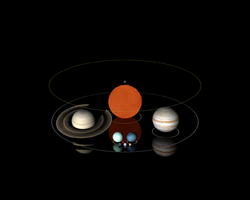- 100 megametres
-
To help compare different orders of magnitude, this page lists lengths starting at 108 metres (100 megametres or 100,000 kilometres or 62,150 miles).
Distances shorter than 108 metres
- 102 Mm — Diameter of HD 149026 b, an unusually dense Jovian planet
- 111.191 Mm — 20,000 (nautical, British) leagues (see Jules Verne, Twenty Thousand Leagues Under the Sea)
- 120 Mm — Diameter of Saturn
- 140 Mm — Diameter of Jupiter
- 174 Mm — Diameter of OGLE-TR-122b, the smallest known star
- 180 Mm — Diameter of TrES-4, the largest known planet
- 196 Mm — Diameter of Proxima Centauri, a typical red dwarf
- 299.792 Mm — One light second; the distance light travels in vacuum in one second (see speed of light)
- 384.4 Mm (238,855 mi) — Average Earth-Moon distance[1]
Distances longer than 109 metres
See also
 Click on the thumbnail image to jump to the desired order of length magnitude: top-left is 1e6m, lower-right is 1e17m. (Image description)
Click on the thumbnail image to jump to the desired order of length magnitude: top-left is 1e6m, lower-right is 1e17m. (Image description)Orders of magnitude for length in E notation shorter than one metre: <−24 −24 −23 −22 −21 −20 −19 −18 −17 −16 −15 −14 −13 −12 −11 −10 −9 −8 −7 −6 −5 −4 −3 −2 −1 0 longer than 1 metre: 1 2 3 4 5 6 7 8 9 10 11 12 13 14 15 16 17 18 19 20 21 22 23 24 25 26 References
- ^ NASA Staff (10 May 2011). ""Solar System Exploration - Earth's Moon: Facts & Figures". NASA. http://solarsystem.nasa.gov/planets/profile.cfm?Display=Facts&Object=Moon. Retrieved 2011-11-06.

This standards- or measurement-related article is a stub. You can help Wikipedia by expanding it.

